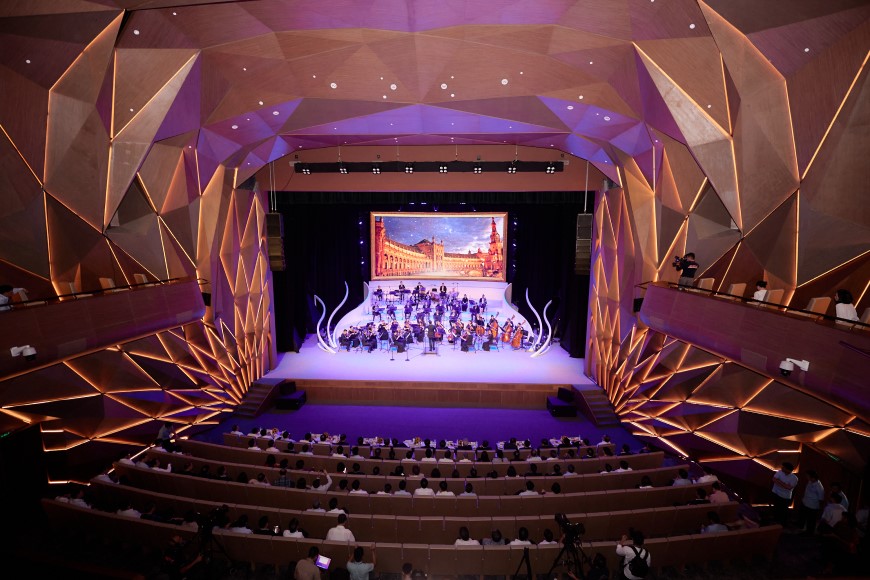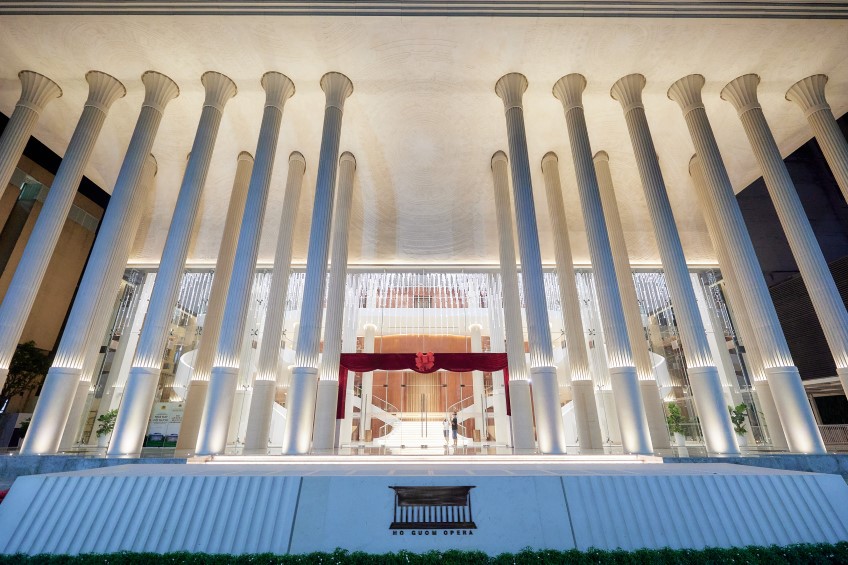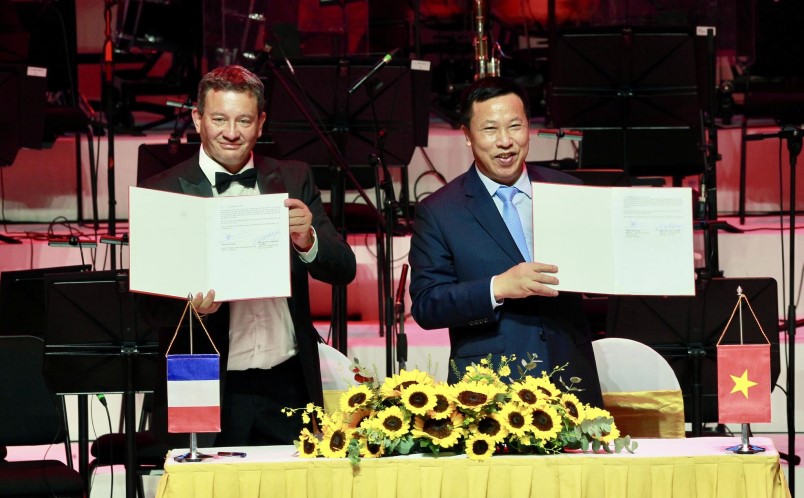Ho Guom Opera comes into view with the highlight of ancient European architecture exuding luxury and splendor from 52 monolithic stone columns imported directly from Spain. The ceiling lighting scheme of the theater's main hall is inspired by the starry night sky with magnificent lights, making the theater shimmer at night.
Every design detail of the roof system and interior of the theater recreates a part of the history of the Vietnamese people through traditional patterns representing Vietnamese culture, such as the sun, crane, Dong Son bronze drums, and ethnic musical instruments.

An art performance marks Ho Guom Opera's inauguration. Photo: The Hanoi Times
Built on an area of 5,000m2, Ho Guom Opera is located at 40-40A Hang Bai Street. It is one of the landmarks in an area rich in cultural works, and historical sites of the capital, forming a cultural, artistic, and entertainment complex around Hoan Kiem Lake. It will contribute to promoting tourism culture and the socio-economic development of Hanoi.
Ho Guom Opera has synchronized and modern facilities of international standards. The large auditorium can seat 900 guests, while the small auditorium can accommodate 500 guests. The stage is expandable for a capacity of 90 musicians. It rotates to create a music pit, a place for musicians to perform, helping the audience fully focus on the stage without obstructing their view. The lighting systems provide the best lighting for the auditorium. The modern stage system creates the most beautiful theatrical scenes.

Ho Guom Opera appears with the highlight of the ancient European architecture, exudes luxury and splendor from 52 monolithic stone columns imported directly from Spain. Photo: The Hanoi Times
This will be the place to showcase Vietnamese and international artworks. With two auditoriums, the most modern stage in Vietnam and Southeast Asia, this place will meet all performance requirements for a variety of different art forms, from ballet to musical, from Western symphonies to Vietnamese traditional and modern music, theater, and other art forms.
On the morning of July 9, the Ho Guom Opera was inaugurated by the Ministry of Public Security and the Hanoi People's Committee.
Speaking at the ceremony, Prime Minister Pham Minh Chinh emphasized that this is one of the iconic cultural and architectural works of the People's Police and contributes to the richness of iconic landmarks in Hanoi.
This cultural institution has a space of modern art and culture mixed with the tradition set in the historical and cultural landscape around Sword Lake to complete a cultural complex in the heart of Hanoi.
The Prime Minister was particularly impressed by this project in its humane design when it created a separate path for people with disabilities; or a harmonious blend between the heroic historical and cultural tradition of Vietnam and the quintessence of modern technology of the world.
Minister of Public Security To Lam thanked the attention and guidance of the State Party leaders, especially the Prime Minister, who has always been keen on improving the cultural and spiritual life of the people.

Leaders of Ho Guom Opera and the Royal Opera of Versailles sign an MoU to enhance cooperation.
Renowned violinist Bui Cong Duy expressed his happiness that Hanoi has a modern and well-invested cultural institution.
"The Ho Guom Opera is located in a prime location in the capital, with advanced and modern equipment. By applying the world's leading technology, the theater meets all the conditions to become one of the world's leading opera houses. I believe this place will also attract world-famous art troupes and artists to perform and exchange," said artist Bui Cong Duy.
Olivier Ochanine, Music Director and Chief Conductor of the Sun Symphony Orchestra, affirmed that this is indeed a special moment for the performing arts in Hanoi and Vietnam in general.
"Ho Guom Opera has the potential to become a concert hall with the best quality rustic sound system in Vietnam, suitable for all kinds of performances from rock music to symphonies," said Olivier Ochanine.
Speaking about the role and position of Ho Guom Opera in the cultural and artistic development of the capital Hanoi, historian Duong Trung Quoc emphasized: "After the Hanoi Opera House, in the past 100 years, we have seen a theater that is both modern and classical, both marking Vietnam's history and telling the story of the present. Like a hyphen from the past to the present and the future, we hope the Ho Guom Opera will become a legacy for future generations, just like the Hanoi Opera House.
Ngo Minh